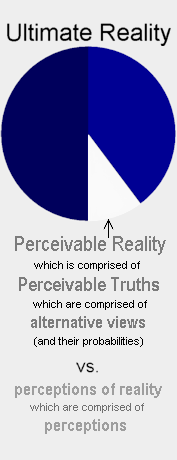
|
|
3 Levels of Reality: Ultimate Reality,
Perceivable Reality,
people's perceptions of reality
Ultimate Reality is the true history of all that existed and now exists within our visible universe and beyond. The entire pie chart
figure at left represents Ultimate Reality. Within this Ultimate Reality is our visible universe that we can sense via
light and other stimuli. This visible universe is represented by the right half of the chart.
The left half of the chart represents the vast unknown outside our visible universe. We can only make
low-probability speculations about what exists in this dark area. It could be far larger and much different from our
visible universe, and mankind may never be able to sense this part of Ultimate Reality.
Perceivable Reality is the part of our visible universe that humankind has been able to sense and about which we have evidence.
It is represented by the white area of the chart. We can use history to estimate the size of this section of the chart relative
to the blue section which represents the part of our visible universe that we have not yet discovered. For example, modern scientific
instruments now allow us to detect parts of our visible universe that are many times larger than what people could see just a few
centuries ago. And science continues to make discoveries about Earth and its biosphere at a rate that indicates there is far more
to be discovered about our Earth than what humanity has discovered and understands. This suggests that humanity is now aware of only a
small part of our visible universe (as shown).
Perceivable Reality is a complex reality that consists of Perceivable Truths about every aspect of Ultimate Reality known to humanity,
from the trivial to the important. And each Perceivable Truth is comprised of all the related evidence and all the alternative views
based on the evidence (i.e. interpretations of the evidence). And each alternative view has an associated probability of
being correct, based on logical criteria for assigning realistic probabilities.
Because Perceivable Reality is comprised of so much evidence and so many Perceivable Truths comprised of alternative views and
their probabilities, nobody can be aware of more than a small part of it. The best we can do is try to achieve an approximate awareness
of Perceivable Reality by trying to understand the most important Perceivable Truths and the most likely alternative views comprising them.
Therefore, people's perceptions of reality are a lower level of reality and they differ greatly from person to person and from one cultural
group to another. To reflect the arbitrary nature of perceptions of reality, this third category of reality is not capitalized.
In general, perceptions of reality are much different than Perceivable Reality. Often they are comprised of perceptions about which the
person is certain, as opposed to the alternative views and probabilities that comprise the Perceivable Truths of Perceivable Reality.
This is why so many people disagree about important aspects of reality and why they have no basis for reaching agreement.
|
|



